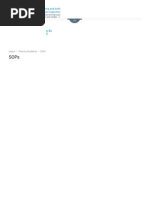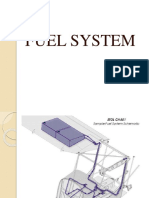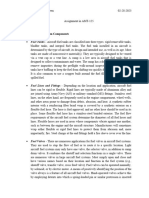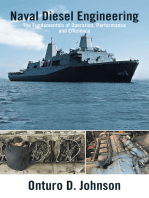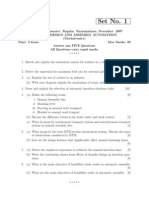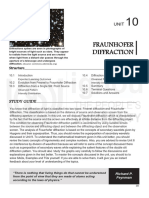0 ratings0% found this document useful (0 votes)
9 viewsPresentation 1
Presentation 1
Uploaded by
tfzpccjkgjCopyright:
© All Rights Reserved
Available Formats
Download as KEY, PDF, TXT or read online from Scribd
Presentation 1
Presentation 1
Uploaded by
tfzpccjkgj0 ratings0% found this document useful (0 votes)
9 views40 pagesCopyright
© © All Rights Reserved
Available Formats
KEY, PDF, TXT or read online from Scribd
Share this document
Did you find this document useful?
Is this content inappropriate?
Copyright:
© All Rights Reserved
Available Formats
Download as KEY, PDF, TXT or read online from Scribd
Download as key, pdf, or txt
0 ratings0% found this document useful (0 votes)
9 views40 pagesPresentation 1
Presentation 1
Uploaded by
tfzpccjkgjCopyright:
© All Rights Reserved
Available Formats
Download as KEY, PDF, TXT or read online from Scribd
Download as key, pdf, or txt
You are on page 1of 40
Basic Fuel System
The basic parts of a fuel system include tanks, boost
pumps, Lines, selector valves, strainers, engine-driven pumps,
and Pressure gauges. A review of fuel systems in the Aviation
Maintenance Technician—The General Handbook provides
some
information concerning these components.
Generally, there are several tanks, even in a simple system,
to store the required amount of fuel. The location of these
tanks
depends on both the fuel system design and the structural
design of the aircraft. From each tank, a line leads to the selector valve. This valve is
set from the cockpit to select the tank from which fuel is to be delivered to the engine.
The boost pump forces fuel through the selector valve to the main line strainer. This
filtering unit, located in the lowest part of the system, removes water and dirt from
the fuel. During starting, the boost pump forces fuel through a bypass in the engine-
driven pump to the metering device. Once the engine-driven pump is rotating at
sufficient speed, it takes over and delivers fuel to the metering device at the specified
pressure.
Fuel Delivery System
The fuel delivery system includes fuel tanks and fuel lines, any fuel
pumps necessary to move the fuel from the tanks to the engine, fuel
strainers to prevent contaminated fuel from entering the engine, a
set of valves and vents to control the movement and pressure in the
system, and a set of fuel level sensors and cockpit gauges.
There are two primary fuel delivery methods typically seen on light
aircraft. The gravity-fed system and the pumped system.
Gravity Fed
As the name implies, a gravity-fed system relies on gravitational force to
feed the engines from the tanks. This is only possible if the tanks are located
higher than the engine, so gravity-fed systems are typically seen on high-
wing aircraft like the Cessna 172. Regulations dictate that the system must
provide a flow rate that is at least 150 % of the take-off fuel consumption of
the engine throughout the certified flight envelope. In some cases, a booster
pump is also installed to augment the gravity-fed system – typically if the
engine is fuel-injected and not running a carburetor-based system.
A typical gravity-fed fuel system of a high-wing, single-engine light aircraft is
shown in the image below.
Pump Fed System
Low wing aircraft with wing mounted tanks require a pump to move the fuel from the
tanks to the carburetor or injectors. A system dependent on a pump to feed the
engines requires a certain level of redundancy in the form of a primary main pump and
a backup auxiliary pump. Both pumps must be independently capable of supplying the
engine at a rate of 125 % of the maximum requirement throughout the certified flight
envelope. If both pumps are operating simultaneously, then the fuel pressure may not
exceed the inlet pressure limits of the engine. In a multi-engine aircraft, each engine
must be capable of operating independent of one-another, and no fuel pump should
be capable of drawing fuel from more than one tank at a time. A failure of any one
component (excluding a fuel tank) may not result in a loss in power of more than one
engine.
A typical pump-fed, low-wing, single engine fuel system is shown below.
Fuel Tanks
Aircraft fuel tanks are subjected to vibration, aerodynamic forces, heat, cold,
inertial loads, and even lightning strikes during typical operation. The tanks
must be designed to withstand all these forces, and not deform under any
loading in the design envelope. They cannot corrode from fuel storage, and
measures should be put in place to minimize (ideally eliminate) the possibility
that foreign contaminants such as dirt, dust, and water could find their way
into the tank.
Tanks cannot be installed on the engine side of the firewall and there must
exist at least half an inch clearance between the tank and the firewall if
installed in the fuselage. They must be isolated from, and clear of personnel
compartments by a fume and fire-proof enclosure. It is important that tanks
remain ventilated at all times so that no accumulation of dangerous fumes or
vapors occurs while in the air or on the ground.
Most aircraft make used of one or more of the three most common tanks in
service today: integral tanks, rigid tanks, and bladder tanks.
Integral Tank
An integral tank (often termed a wet wing) is formed by sealing the aircraft wing
structure in the region designated as a fuel cell. An integral tank is generally
constructed in an aluminum airframe as the aluminum alloy does not corrode
when immersed in fuel. Adequate sealing of the storage region in the wing is very
important, where every rivet, bolt, nut, fuel line, and hose that penetrates the
wing must remain completely sealed. The wing will flex under aerodynamic
loading and expand and contract with ambient temperature changes. The sealing
must be able to accommodate this through the range of operating temperatures
and flight envelope.
Measures are put in place to limit the amount the fuel that can shift and slosh
during maneuvers as the fuel is free to move about the wing structure. Baffles and
guides are built into the wing to assist with this.
Integral tanks are usually lighter than the equivalent rigid metallic tank but may
be more difficult to maintain and repair as the tank cannot be removed or
replaced
Rigid Tank
This is a self-contained tank that is built separately from the aircraft and
installed in either the wing or in the fuselage structure. These are typically
manufactured from three-series aluminum alloy or stainless steel and
installed in special-purpose fuel bays. These tanks are not integral to the
structure and so must be adequately supported by the aircraft structure
through the aircraft’s entire operating envelope.
Bladder Tank
A bladder tank is similar to a rigid tank in the sense that the tank is
manufactured separately from the airframe and installed during assembly. It
is constructed from a reinforced flexible material like synthetic rubber and so,
unlike a rigid tank, does not require a large cut-out in the airframe structure
to install. Installation may take place by rolling up the deflated tank, inserting
the bladder through an inspection hole, and then unrolling it into place. It is
important to install a bladder tank without any wrinkles so that contaminants
do not get trapped in the tank.
Fuel Metering Devices for Reciprocating Engines
Basic principles of operation are discussed here with no attempt being made to
give detailed maintenance instructions. For the specific information needed to
inspect or maintain a particular
installation or unit, consult the manufacturer’s instructions.
The basic requirement of a reciprocating fuel metering system is the same,
regardless of the type of system used or the model engine on which the
equipment is installed. It must meter fuel
proportionately to air to establish the proper fuel/air mixture ratio for the
engine at all speeds and altitudes at which the engine may be operated. In the
fuel/air mixture curves shown
in Figure 2-1, note that the basic best power and best economy fuel/air
mixture requirements for reciprocating engines are approximately the same.
The fuel metering system must
Fuel/Air Mixtures
Gasoline and other liquid fuels do not burn at all unless they are mixed with
air. If the mixture is to burn properly within the engine cylinder, the ratio of air
to fuel must be kept within a certain range. It would be more accurate to state
that the fuel is burned with the oxygen in the air. Seventy-eight percent of air
by volume is nitrogen, which is inert and does not participate in the
combustion process, and 21 percent is oxygen. Heat is generated by burning
the mixture of gasoline and oxygen. Nitrogen and gaseous byproducts of
combustion
Aviation fuels
petroleum-based fuels, or petroleum and synthetic fuel blends, are
used to power aircraft. They have more stringent requirements than fuels
used for ground use, such as heating and road transport, and contain
additives to enhance or maintain properties important to fuel performance
or handling. They are kerosene-based (JP-8 and Jet A-1) for gas turbine-
powered aircraft. Piston-engine aircraft use leaded gasoline and those with
diesel engines may use jet fuel (kerosene).[1] By 2012, all aircraft operated
by the U.S. Air Force had been certified to use a 50-50 blend of kerosene and
synthetic fuel derived from coal or natural gas as a way of stabilizing the cost
of fuel.
Jet fuel is a clear to straw-colored fuel, based on either an unleaded
kerosene (Jet A-1) or a naphtha-kerosene blend (Jet B). Similar to diesel
fuel, it can be used in either compression ignition engines or turbine
engines.
Jet-A powers modern commercial airliners and is a mix of extremely
refined kerosene and burns at temperatures at or above 49 °C (120 °F).
Kerosene-based fuel has a much higher flash point than gasoline-based
fuel, meaning that it requires a significantly higher temperature to ignite.
It is a high-quality fuel; if it fails the purity and other quality tests for use
on jet aircraft, it is sold to ground-based users with less demanding
requirements, such as railroads.
Avgas (aviation gasoline) is used by small aircraft, light
helicopters, and vintage piston-engine aircraft. Its formulation is
distinct from the conventional gasoline (UK: petrol, or "aviation
spirit" in this context) used in motor vehicles which are commonly
called mogas or autogas in an aviation context.[4] Although it comes
in many different grades, its octane rating is higher than that for
"regular" motor gasoline.
The engine fuel system must supply fuel to the engine’s
fuel metering device under all conditions of ground and air
operation. It must function properly at constantly changing
altitudes and in any climate. The most common fuels are
AVGAS for reciprocating engines and Jet A for turbine
engines. AVGAS is generally either 80 (red) or 100LL (blue)
octane. The LL stands for low lead although it contains four
times the lead of 80 octane AVGAS. Jet A is a kerosene-
based fuel that is clear to straw in color.
Avgas (aviation gasoline) is used by small aircraft, light
helicopters, and vintage piston-engine aircraft. Its formulation is
distinct from the conventional gasoline (UK: petrol, or "aviation
spirit" in this context) used in motor vehicles which are commonly
called mogas or autogas in an aviation context.[4] Although it comes
in many different grades, its octane rating is higher than that for
"regular" motor gasoline.
The composition of the fuel/air mixture is described by the
mixture ratio. For example, a mixture with a ratio of 12 to 1
(12:1) is made up of 12 pounds of air and 1 pound of fuel. The
ratio is expressed in weight because the volume of air varies
greatly with temperature and pressure. The mixture ratio can
also be expressed as a decimal. Thus, a fuel/air ratio of 12:1
and a fuel/air ratio of 0.083 describe the same mixture ratio.
Mixtures of air and gasoline as rich as 8:1 and as lean as 16:1
will burn in an engine cylinder, but beyond these mixtures,
either lean or rich blow out could occur. The engine develops
maximum power with a mixture of approximately 12 parts
of air and 1 part gasoline by weight
From a chemist’s point of view, the perfect mixture for
combustion of fuel and air would be 0.067 pounds of fuel
to 1 pound of air (mixture ratio of 15:1). The scientist calls
this chemically correct combination a stoichiometric mixture
(pronounced stoy-key-o-metric). With this mixture (given
sufficient time and turbulence), all the fuel and all the oxygen
in the air is completely used in the combustion process. The
stoichiometric mixture produces the highest combustion
temperatures because the proportion of heat released to a
mass of charge (fuel and air) is the greatest. If more fuel is
added to the same quantity of air charge than the amount
giving a chemically perfect mixture, changes of power
and temperature occur. The combustion gas temperature is
lowered as the mixture is enriched, and the power increases
until the fuel/air ratio is approximately 0.0725. For mixtures
from 0.0725 fuel/air ratio to 0.080 fuel/air ratio, the power
remains essentially constant even though the combustion
Fuel System Inspection and Maintenance
The inspection of a fuel system installation consists basically of
an examination of the system for conformity to design requirements
together with functional tests to prove correct operation. Since
there are considerable variations in the
fuel systems used on different aircraft, no attempt has
been made to describe any particular system in detail. It is
important that the manufacturer’s instructions for the aircraft
concerned be followed when performing inspection or
maintenance functions.
Complete System
Inspect the entire system for wear, damage, or leaks. Make
sure that all units are securely attached and properly safetied.
The drain plugs or valves in the fuel system should be opened
to check for the presence of sediment or water. The filter
and sump should also be checked for sediment, water, or
slime. The filters or screens, including those provided for
flowmeters and auxiliary pumps, must be clean and free from
corrosion. The controls should be checked for freedom of
movement, security of locking, and freedom from damage
due to chafing. The fuel vents should be checked for correct
positioning and freedom from obstruction; otherwise, fuel
flow or pressure fueling may be affected. Filler neck drains
should be checked for freedom from obstruction.
Fuel Tanks
All applicable panels in the aircraft skin or structure should
be removed and the tanks inspected for corrosion on the
external surfaces, for security of attachment, and for correct
adjustment of straps and slings. Check the fittings and
connections for leaks or failures.
Some fuel tanks manufactured of light alloy materials are
provided with inhibitor cartridges to reduce the corrosive
effects of combined leaded fuel and water. Where
applicable, the cartridge should be inspected and renewed
at the specified periods.
Selector Valves
Rotate selector valves and check for free operation, excessive
backlash, and accurate pointer indication. If the backlash
is excessive, check the entire operating mechanism for
worn joints, loose pins, and broken drive lugs. Replace any
defective parts. Inspect cable control systems for worn or
frayed cables, damaged pulleys, or worn pulley bearings.
Pumps
During an inspection of booster pumps, check for the
following conditions:
1. Proper operation
2. Leaks and condition of fuel and electrical connections
3. Wear of motor brushes
Be sure the drain lines are free of traps, bends, or restrictions.
Check the engine-driven pump for leaks and security of
mounting. Check the vent and drain lines for obstructions.
Main Line Strainers
Drain water and sediment from the main line strainer at
each preflight inspection. Remove and clean the screen at
the periods specified in the airplane maintenance manual.
Examine the sediment removed from the housing. Particles of
rubber are often early warnings of hose deterioration. Check
for leaks and damaged gaskets.
Fuel Quantity Gauges
If a sight gauge is used, be sure that the glass is clear and that
there are no leaks at the connections. Check the lines leading to
it for leaks and security of attachments. Check the mechanical
gauges for free movement of the float arm and proper
synchronization of the pointer with the position of the float.
Fuel Pressure Gauge
Check the pointer for zero tolerance and excessive oscillation.
Check the cover glass for looseness and proper range
markings. Check the lines and connections for leaks. Be sure
that there is no obstruction in the vent. Replace the instrument
if it is defective.
You might also like
- Marvel-Schebler Carburetor Repair ManualDocument21 pagesMarvel-Schebler Carburetor Repair Manualbedford24100% (14)
- Spread Footing Design: U D A P QDocument18 pagesSpread Footing Design: U D A P QOnline Review Specialists100% (1)
- Chapter 7 Engine Fuel and Fuel MeteringDocument76 pagesChapter 7 Engine Fuel and Fuel MeteringRobertNo ratings yet
- AIRCRAFT FUEL Hydrant System DesignDocument13 pagesAIRCRAFT FUEL Hydrant System DesignJosé Marcial Díaz Dávila100% (4)
- Aircraft Fuel SystemsDocument46 pagesAircraft Fuel SystemsRajesh Kumar Verma100% (3)
- SOPs - Pharma PathwayDocument7 pagesSOPs - Pharma PathwayDeepakNo ratings yet
- AZ Secy/State App For Attorneys' Fees vs. AZGOPDocument11 pagesAZ Secy/State App For Attorneys' Fees vs. AZGOPpaul weichNo ratings yet
- IbnesinaDocument19 pagesIbnesinaMehady HassanNo ratings yet
- Chapter 10 - Fuel SystemsDocument87 pagesChapter 10 - Fuel SystemsKHAWAJA ZOHAIR NADEEM100% (1)
- Aircraft Fuel SystemDocument10 pagesAircraft Fuel SystemTamara AntonyNo ratings yet
- AircraftSystems Week 10 11 MergedDocument45 pagesAircraftSystems Week 10 11 MergedJake BarettoNo ratings yet
- Assignment A (Mursalin)Document27 pagesAssignment A (Mursalin)Mehady HassanNo ratings yet
- Aircraft Fuel SystemDocument27 pagesAircraft Fuel SystemfaitholuwabankeNo ratings yet
- Landing Gear, Aircraft Fuel Systems - Lec 4Document61 pagesLanding Gear, Aircraft Fuel Systems - Lec 4aahsan345No ratings yet
- Aircraft Fuel SystemsDocument41 pagesAircraft Fuel SystemsHarry Nagaño100% (4)
- Aircraft Fuel System - Wikipedia, The Free Encyclopedia PDFDocument3 pagesAircraft Fuel System - Wikipedia, The Free Encyclopedia PDFFaizan MuhammadNo ratings yet
- Aircraft Fuel SystemDocument9 pagesAircraft Fuel SystemJabez RichardsNo ratings yet
- All systems c172s NAV IIIDocument21 pagesAll systems c172s NAV IIIaung184596No ratings yet
- Aircraft Fuel Systems: Gravity-Feed SystemDocument3 pagesAircraft Fuel Systems: Gravity-Feed SystemJabez RichardsNo ratings yet
- Amt 1201 - Prelim - Lab Module 1 - DelgadoDocument3 pagesAmt 1201 - Prelim - Lab Module 1 - DelgadoBrendan Lewis DelgadoNo ratings yet
- Manufacturing and Maintenance Operations For Bladder-Type Aircraft Fuel TanksDocument31 pagesManufacturing and Maintenance Operations For Bladder-Type Aircraft Fuel TanksИван КоньковNo ratings yet
- Chapter 7 - Engine Fuel SystemsDocument126 pagesChapter 7 - Engine Fuel SystemsKim RioverosNo ratings yet
- Unit 3 Fuel SystemDocument32 pagesUnit 3 Fuel Systemuthira100% (1)
- Amt 1201 - Prelim - Module 1 - DelgadoDocument4 pagesAmt 1201 - Prelim - Module 1 - DelgadoBrendan Lewis DelgadoNo ratings yet
- Engine Fuel and Fuel MeteringDocument70 pagesEngine Fuel and Fuel Meteringjeremyallan.ligeroNo ratings yet
- AsifDocument23 pagesAsifMehady HassanNo ratings yet
- Chapter - 5 Fuel Supply SystemsDocument8 pagesChapter - 5 Fuel Supply SystemsKenmoe T DonasNo ratings yet
- Tite Ni Kip Mahaba at MatabaDocument5 pagesTite Ni Kip Mahaba at MatabaKobe Alcantara ReyesNo ratings yet
- Fuel SystemDocument7 pagesFuel SystemখালিদহাসানNo ratings yet
- Airframe Oral & Practical Study Guide: Fuel SystemsDocument3 pagesAirframe Oral & Practical Study Guide: Fuel SystemsEduardo QuinteroNo ratings yet
- Electronic Fuel InjectionDocument13 pagesElectronic Fuel InjectionTerrence JimNo ratings yet
- Aviation FuelDocument2 pagesAviation Fuelnatun4aNo ratings yet
- Aircraft Fuel Systems. AYR CDocument37 pagesAircraft Fuel Systems. AYR CAKANKSHA PANDEYNo ratings yet
- Air-Fuel Requirement in SI Engines: Unit Ii Fuel SystemsDocument62 pagesAir-Fuel Requirement in SI Engines: Unit Ii Fuel SystemsdurgapriyaNo ratings yet
- Aviation FuelingDocument9 pagesAviation FuelingSaju V Eugine100% (1)
- Dellorto Carburador Manual Principios Basicos - InglesDocument34 pagesDellorto Carburador Manual Principios Basicos - InglesDani-meganeboyNo ratings yet
- Aircraft Fuel SystemDocument12 pagesAircraft Fuel SystemAditya ThakurNo ratings yet
- Engine OverhulingDocument26 pagesEngine OverhulingtselothaiilemariamNo ratings yet
- DUEL Fuel EnginesDocument11 pagesDUEL Fuel EnginesMohamed Al Nazooque0% (1)
- Iae Finals NotesDocument8 pagesIae Finals NotescrestiawritesNo ratings yet
- Fuel Systems - 2004Document26 pagesFuel Systems - 2004Victor NunezNo ratings yet
- CarburetorDocument19 pagesCarburetortselothaiilemariamNo ratings yet
- Fuel Supply System Petrol EngineDocument7 pagesFuel Supply System Petrol EngineAmarChaudhary0% (1)
- Report AirsystemDocument24 pagesReport Airsystemchristian pagtamaNo ratings yet
- Aircraft Fuel Systems: by Biruck Abraham National Aviation CollegeDocument47 pagesAircraft Fuel Systems: by Biruck Abraham National Aviation CollegeZelalem BirahunNo ratings yet
- Chapter 1Document61 pagesChapter 1anup chauhanNo ratings yet
- 2.16.1 Principles of Forced InductionDocument8 pages2.16.1 Principles of Forced Inductionstefanovicana1No ratings yet
- Ch.7 Se.a Fuel SystemDocument44 pagesCh.7 Se.a Fuel Systemashraf.shqair1992No ratings yet
- Engine Lubrication System: The Importance of LubricationDocument4 pagesEngine Lubrication System: The Importance of LubricationPyae Sone LonnNo ratings yet
- Aircraft Fuel and Fuel SystemDocument10 pagesAircraft Fuel and Fuel SystemPathan FatimaNo ratings yet
- Fuel Systems: Submitted By: L.Ramkiran Monisha Patel ADocument22 pagesFuel Systems: Submitted By: L.Ramkiran Monisha Patel Amanishanageshrai27No ratings yet
- Fuel Supply System of Petrol EngineDocument8 pagesFuel Supply System of Petrol EngineSeena Sharma0% (1)
- Unit 3 Fuel SystemDocument58 pagesUnit 3 Fuel SystemuthiraNo ratings yet
- AC Fuel SystemsDocument13 pagesAC Fuel SystemsChouaib Ben BoubakerNo ratings yet
- Amt 1201 - Prelim - Lab Module 2 - DelgadoDocument5 pagesAmt 1201 - Prelim - Lab Module 2 - DelgadoBrendan Lewis DelgadoNo ratings yet
- 01 Study of CarburetorDocument13 pages01 Study of CarburetorSAMRUDDHI SARDARNo ratings yet
- Aircraft SystemsDocument115 pagesAircraft SystemsAntonov VodkaNo ratings yet
- Chapter 4Document28 pagesChapter 4Rihab MansNo ratings yet
- Aircraft Fuel SystemsDocument117 pagesAircraft Fuel SystemsfuelcombNo ratings yet
- Naval Mechanical Engineering: Gas Turbine Propulsion, Auxiliary, and Engineering Support SystemsFrom EverandNaval Mechanical Engineering: Gas Turbine Propulsion, Auxiliary, and Engineering Support SystemsNo ratings yet
- Comparison of Diesel and Petrol EnginesFrom EverandComparison of Diesel and Petrol EnginesRating: 2.5 out of 5 stars2.5/5 (3)
- Naval Diesel Engineering: The Fundamentals of Operation, Performance and EfficiencyFrom EverandNaval Diesel Engineering: The Fundamentals of Operation, Performance and EfficiencyNo ratings yet
- 4-On The Adoption of The Universal Declaration of Human Rights-ERDocument5 pages4-On The Adoption of The Universal Declaration of Human Rights-ERCame PascualNo ratings yet
- PAXA50 Card Reader Merchant Specific ConditionsDocument3 pagesPAXA50 Card Reader Merchant Specific ConditionsCharanTheja RallaNo ratings yet
- Net Or: From Mainly Network. Every Computer Is To The Network But The May Network 1 3Document5 pagesNet Or: From Mainly Network. Every Computer Is To The Network But The May Network 1 3Barinder SinghNo ratings yet
- Rr411402 Product Design and Assembly AutomationDocument4 pagesRr411402 Product Design and Assembly AutomationSrinivasa Rao GNo ratings yet
- Buddhist Scriptures The Chinese CanonDocument4 pagesBuddhist Scriptures The Chinese Canonreader1453No ratings yet
- 玩物丧志 (Plaything) - Love you is my fault PDFDocument147 pages玩物丧志 (Plaything) - Love you is my fault PDFmiracleNo ratings yet
- OBSTETRICSDocument8 pagesOBSTETRICSAqua LakeNo ratings yet
- Unit 10Document28 pagesUnit 10MuhîbNo ratings yet
- EU Trade Shows For Home Decoration, Gifts and Home TextilesDocument24 pagesEU Trade Shows For Home Decoration, Gifts and Home TextilesReinhard WernerNo ratings yet
- Stratigraphy Lecture NotesDocument7 pagesStratigraphy Lecture NotesOyedotun Tunde100% (4)
- Gov. Larry Hogan's 'Stay at Home' Order 3.30.20Document8 pagesGov. Larry Hogan's 'Stay at Home' Order 3.30.20WJZ89% (9)
- Bart Said: "I Won't Do It Again, Dad".: Reporting VerbsDocument2 pagesBart Said: "I Won't Do It Again, Dad".: Reporting VerbsAna Losada PérezNo ratings yet
- Special Operations Nutrition GuideDocument225 pagesSpecial Operations Nutrition GuideMatthew S MaynardNo ratings yet
- Week of December 18th: Morning PrayerDocument8 pagesWeek of December 18th: Morning Prayerapi-305101767No ratings yet
- CHP Eight StatisticDocument17 pagesCHP Eight StatisticFaris SyahmiNo ratings yet
- Student Difficulties With Linearity and Linear Functions and Teachers' Understanding of Student DifficultiesDocument303 pagesStudent Difficulties With Linearity and Linear Functions and Teachers' Understanding of Student DifficultiesUsada ShepardNo ratings yet
- American Realty Vs Bank of AmericaDocument3 pagesAmerican Realty Vs Bank of AmericaXing Keet LuNo ratings yet
- Philam Insurance Company Inc. Vs Heung-A-Shipping Corporation and Wallem Philippines Shipping, Inc. DigestDocument3 pagesPhilam Insurance Company Inc. Vs Heung-A-Shipping Corporation and Wallem Philippines Shipping, Inc. DigestRichard Gultiano Libago100% (1)
- School Recycling Project PROPOSALDocument3 pagesSchool Recycling Project PROPOSALJendae100% (1)
- 006 - SWP - Manual HandlingDocument2 pages006 - SWP - Manual HandlingPhanankosi DubeNo ratings yet
- Final Darft Version 3 Joint AWD Preparedness and Response Plan - Health and WASH - 26 Nov 2018Document10 pagesFinal Darft Version 3 Joint AWD Preparedness and Response Plan - Health and WASH - 26 Nov 2018Rubel RanaNo ratings yet
- Pollution Water AgricultureDocument20 pagesPollution Water AgricultureSikder Mohammod Ekteder NabilNo ratings yet
- Annual Lesson Plan 12Document4 pagesAnnual Lesson Plan 12hambisatiruneh6No ratings yet
- MODULE 1 Human BehaviorDocument34 pagesMODULE 1 Human Behaviorlloren.1999.napNo ratings yet
- Summary of English Grammar For 3rd YearsDocument4 pagesSummary of English Grammar For 3rd YearsMouni MounNo ratings yet
- B1 U3 Extra Grammar Practice ReinforcementDocument1 pageB1 U3 Extra Grammar Practice ReinforcementpereyralopezaimeNo ratings yet
- Pre Immersion12 Q3 SLM 2Document10 pagesPre Immersion12 Q3 SLM 2WilmerNo ratings yet





